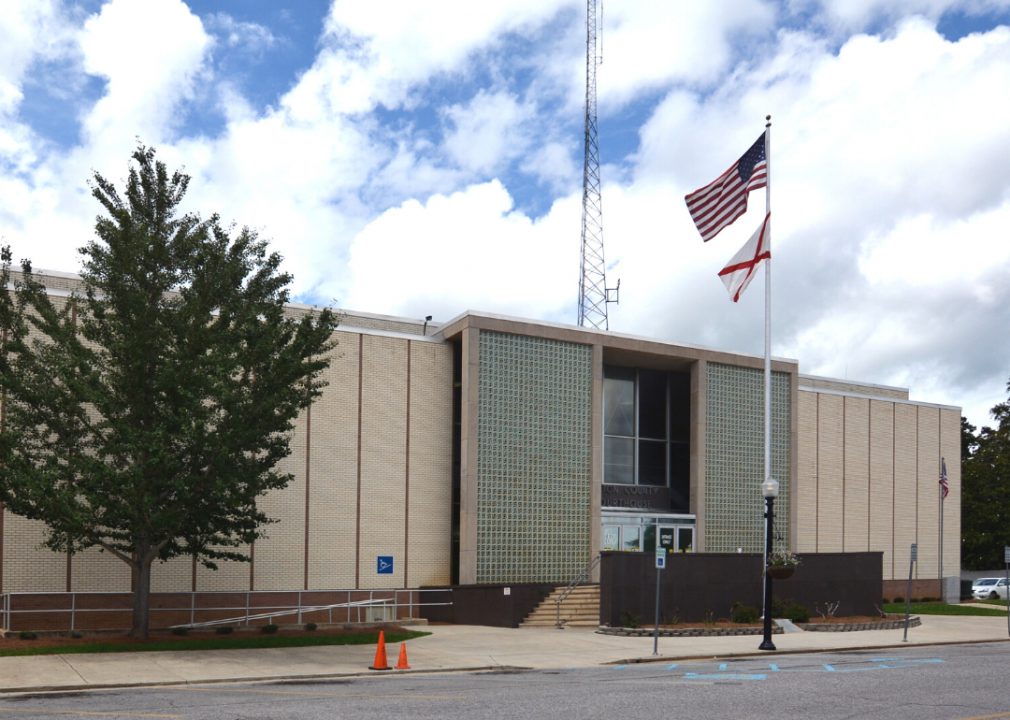Counties with the highest rate of food insecurity in Alabama
Published 3:30 pm Saturday, February 5, 2022
Canva
Counties with the highest rate of food insecurity in Alabama
Every county in the United States is home to people experiencing food insecurity, defined by the nonprofit Feeding America as “a lack of consistent access to enough food for every person in a household to live an active, healthy life.”
The USDA estimates that 89.5% of U.S. households were food secure throughout 2019—that’s 116.0 million people. The COVID-19 pandemic put further strain on households already experiencing food hardship, with Feeding America estimating that 42 million people, or 1 in 8 Americans, may experience food insecurity in 2021. This is a slight improvement from 2020 numbers but still represents an enormous burden for millions of children and adults.
Stacker compiled a list of counties in Alabama with the highest rate of food insecurity using data from Feeding America. Counties are ranked by highest percent of population with food insecurity as of 2019.
![]()
Rivers A. Langley; SaveRivers // Wikimedia Commons
#50. Randolph County
– Food insecurity rate: 15.5% (3,520 total)
— 42.2% higher than national average
– Child food insecurity rate: 21.7% (1,060 total)
— 48.6% higher than national average
– Annual food budget shortfall: $1,770,000
— Cost per meal: $2.94

Wayne James // Shutterstock
#49. Lauderdale County
– Food insecurity rate: 15.5% (14,340 total)
— 42.2% higher than national average
– Child food insecurity rate: 17.5% (3,200 total)
— 19.9% higher than national average
– Annual food budget shortfall: $7,078,000
— Cost per meal: $2.89
Canva
#48. Bullock County
– Food insecurity rate: 15.7% (1,610 total)
— 44.0% higher than national average
– Child food insecurity rate: 31.7% (670 total)
— 117.1% higher than national average
– Annual food budget shortfall: $909,000
— Cost per meal: $3.30
Calvin Beale // Wikimedia Commons
#47. Coffee County
– Food insecurity rate: 15.7% (8,130 total)
— 44.0% higher than national average
– Child food insecurity rate: 20.0% (2,450 total)
— 37.0% higher than national average
– Annual food budget shortfall: $4,847,000
— Cost per meal: $3.49
Chris Pruitt // Wikimedia Commons
#46. Autauga County
– Food insecurity rate: 15.7% (8,670 total)
— 44.0% higher than national average
– Child food insecurity rate: 19.6% (2,590 total)
— 34.2% higher than national average
– Annual food budget shortfall: $4,439,000
— Cost per meal: $3.00

Altairisfar // Wikicommons
#45. Mobile County
– Food insecurity rate: 15.8% (65,300 total)
— 45.0% higher than national average
– Child food insecurity rate: 22.4% (21,890 total)
— 53.4% higher than national average
– Annual food budget shortfall: $36,157,000
— Cost per meal: $3.24
Chris Pruitt // Wikimedia Commons
#44. Conecuh County
– Food insecurity rate: 16.0% (1,990 total)
— 46.8% higher than national average
– Child food insecurity rate: 25.9% (680 total)
— 77.4% higher than national average
– Annual food budget shortfall: $1,009,000
— Cost per meal: $2.97
Rudi Weikard // Wikimedia Commons
#43. Cherokee County
– Food insecurity rate: 16.1% (4,170 total)
— 47.7% higher than national average
– Child food insecurity rate: 16.8% (880 total)
— 15.1% higher than national average
– Annual food budget shortfall: $2,157,000
— Cost per meal: $3.03
Canva
#42. Bibb County
– Food insecurity rate: 16.3% (3,680 total)
— 49.5% higher than national average
– Child food insecurity rate: 21.8% (1,010 total)
— 49.3% higher than national average
– Annual food budget shortfall: $1,861,000
— Cost per meal: $2.96
Rudi Weikard // Wikimedia Commons
#41. Franklin County
– Food insecurity rate: 16.3% (5,130 total)
— 49.5% higher than national average
– Child food insecurity rate: 21.2% (1,670 total)
— 45.2% higher than national average
– Annual food budget shortfall: $2,477,000
— Cost per meal: $2.82
Rivers A. Langley; SaveRivers // Wikimedia Commons
#40. Tallapoosa County
– Food insecurity rate: 16.4% (6,650 total)
— 50.5% higher than national average
– Child food insecurity rate: 24.2% (2,050 total)
— 65.8% higher than national average
– Annual food budget shortfall: $3,618,000
— Cost per meal: $3.18
Chris Pruitt // Wikimedia Commons
#39. Cullman County
– Food insecurity rate: 16.4% (13,610 total)
— 50.5% higher than national average
– Child food insecurity rate: 17.4% (3,260 total)
— 19.2% higher than national average
– Annual food budget shortfall: $7,226,000
— Cost per meal: $3.11

Carol M. Highsmith/Library of Congress // Wikimedia Commons
#38. Houston County
– Food insecurity rate: 16.4% (17,160 total)
— 50.5% higher than national average
– Child food insecurity rate: 22.0% (5,360 total)
— 50.7% higher than national average
– Annual food budget shortfall: $9,732,000
— Cost per meal: $3.32
JNix // Shutterstock
#37. Clay County
– Food insecurity rate: 16.5% (2,200 total)
— 51.4% higher than national average
– Child food insecurity rate: 20.4% (570 total)
— 39.7% higher than national average
– Annual food budget shortfall: $1,164,000
— Cost per meal: $3.09
Chris Pruitt // Wikimedia Commons
#36. Butler County
– Food insecurity rate: 16.5% (3,280 total)
— 51.4% higher than national average
– Child food insecurity rate: 25.6% (1,140 total)
— 75.3% higher than national average
– Annual food budget shortfall: $1,779,000
— Cost per meal: $3.17
Dailynetworks // Wikimedia Commons
#35. Colbert County
– Food insecurity rate: 16.5% (9,040 total)
— 51.4% higher than national average
– Child food insecurity rate: 19.9% (2,300 total)
— 36.3% higher than national average
– Annual food budget shortfall: $4,379,000
— Cost per meal: $2.83
Rivers Langley SaveRivers // Wikimedia Commons
#34. Russell County
– Food insecurity rate: 16.8% (9,730 total)
— 54.1% higher than national average
– Child food insecurity rate: 23.6% (3,350 total)
— 61.6% higher than national average
– Annual food budget shortfall: $5,306,000
— Cost per meal: $3.19
Rivers Langley; SaveRivers // Wikimedia Commons
#33. Talladega County
– Food insecurity rate: 16.8% (13,530 total)
— 54.1% higher than national average
– Child food insecurity rate: 23.4% (4,040 total)
— 60.3% higher than national average
– Annual food budget shortfall: $7,076,000
— Cost per meal: $3.06
Prestinian // Wikimedia Commons
#32. Etowah County
– Food insecurity rate: 16.8% (17,250 total)
— 54.1% higher than national average
– Child food insecurity rate: 22.4% (4,960 total)
— 53.4% higher than national average
– Annual food budget shortfall: $8,851,000
— Cost per meal: $3.00
Carol M. Highsmith // Wikimedia Commons
#31. Hale County
– Food insecurity rate: 16.9% (2,510 total)
— 55.0% higher than national average
– Child food insecurity rate: 28.5% (980 total)
— 95.2% higher than national average
– Annual food budget shortfall: $1,436,000
— Cost per meal: $3.35
Kreeder13 // Wikimedia Commons
#30. Pike County
– Food insecurity rate: 16.9% (5,640 total)
— 55.0% higher than national average
– Child food insecurity rate: 23.7% (1,530 total)
— 62.3% higher than national average
– Annual food budget shortfall: $3,275,000
— Cost per meal: $3.40
Canva
#29. Marshall County
– Food insecurity rate: 17.1% (16,380 total)
— 56.9% higher than national average
– Child food insecurity rate: 20.0% (4,780 total)
— 37.0% higher than national average
– Annual food budget shortfall: $8,035,000
— Cost per meal: $2.87
Canva
#28. Chilton County
– Food insecurity rate: 17.2% (7,590 total)
— 57.8% higher than national average
– Child food insecurity rate: 19.4% (2,060 total)
— 32.9% higher than national average
– Annual food budget shortfall: $3,920,000
— Cost per meal: $3.02
Canva
#27. DeKalb County
– Food insecurity rate: 17.2% (12,300 total)
— 57.8% higher than national average
– Child food insecurity rate: 19.4% (3,390 total)
— 32.9% higher than national average
– Annual food budget shortfall: $6,439,000
— Cost per meal: $3.06
Rivers Langley; SaveRivers // Wikimedia Commons
#26. Calhoun County
– Food insecurity rate: 17.2% (19,660 total)
— 57.8% higher than national average
– Child food insecurity rate: 22.6% (5,630 total)
— 54.8% higher than national average
– Annual food budget shortfall: $10,000,000
— Cost per meal: $2.98
Canva
#25. Marengo County
– Food insecurity rate: 17.3% (3,350 total)
— 58.7% higher than national average
– Child food insecurity rate: 26.4% (1,160 total)
— 80.8% higher than national average
– Annual food budget shortfall: $1,724,000
— Cost per meal: $3.01
Canva
#24. Lawrence County
– Food insecurity rate: 17.7% (5,850 total)
— 62.4% higher than national average
– Child food insecurity rate: 21.2% (1,520 total)
— 45.2% higher than national average
– Annual food budget shortfall: $3,036,000
— Cost per meal: $3.04
Canva
#23. Escambia County
– Food insecurity rate: 17.7% (6,570 total)
— 62.4% higher than national average
– Child food insecurity rate: 24.2% (2,000 total)
— 65.8% higher than national average
– Annual food budget shortfall: $3,353,000
— Cost per meal: $2.99
Public Domain
#22. Pickens County
– Food insecurity rate: 17.8% (3,610 total)
— 63.3% higher than national average
– Child food insecurity rate: 28.7% (1,160 total)
— 96.6% higher than national average
– Annual food budget shortfall: $2,085,000
— Cost per meal: $3.38
Michael Rivera // Wikimedia Commons
#21. Dale County
– Food insecurity rate: 17.8% (8,790 total)
— 63.3% higher than national average
– Child food insecurity rate: 23.2% (2,640 total)
— 58.9% higher than national average
– Annual food budget shortfall: $4,830,000
— Cost per meal: $3.21
Chris Pruitt // Wikimedia Commons
#20. Covington County
– Food insecurity rate: 18.1% (6,730 total)
— 66.1% higher than national average
– Child food insecurity rate: 23.4% (1,910 total)
— 60.3% higher than national average
– Annual food budget shortfall: $3,455,000
— Cost per meal: $3.00
Springfieldohio // Wikimedia Commons
#19. Jackson County
– Food insecurity rate: 18.1% (9,390 total)
— 66.1% higher than national average
– Child food insecurity rate: 20.6% (2,270 total)
— 41.1% higher than national average
– Annual food budget shortfall: $4,801,000
— Cost per meal: $2.99
Rivers Langley; SaveRivers // Wikimedia Commons
#18. Cleburne County
– Food insecurity rate: 18.2% (2,710 total)
— 67.0% higher than national average
– Child food insecurity rate: 21.8% (740 total)
— 49.3% higher than national average
– Annual food budget shortfall: $1,399,000
— Cost per meal: $3.02
Idawriter // Wikimedia Commons
#17. Washington County
– Food insecurity rate: 18.4% (3,050 total)
— 68.8% higher than national average
– Child food insecurity rate: 27.2% (1,030 total)
— 86.3% higher than national average
– Annual food budget shortfall: $1,699,000
— Cost per meal: $3.26
Altairisfar // Wikimedia Commons
#16. Clarke County
– Food insecurity rate: 18.6% (4,490 total)
— 70.6% higher than national average
– Child food insecurity rate: 25.4% (1,340 total)
— 74.0% higher than national average
– Annual food budget shortfall: $2,264,000
— Cost per meal: $2.95
Canva
#15. Walker County
– Food insecurity rate: 18.6% (11,950 total)
— 70.6% higher than national average
– Child food insecurity rate: 22.6% (3,220 total)
— 54.8% higher than national average
– Annual food budget shortfall: $5,820,000
— Cost per meal: $2.85
Myself – Nathon Morris // Wikimedia Commons
#14. Lamar County
– Food insecurity rate: 18.7% (2,590 total)
— 71.6% higher than national average
– Child food insecurity rate: 24.4% (740 total)
— 67.1% higher than national average
– Annual food budget shortfall: $1,345,000
— Cost per meal: $3.04
Canva
#13. Winston County
– Food insecurity rate: 18.7% (4,460 total)
— 71.6% higher than national average
– Child food insecurity rate: 22.5% (1,110 total)
— 54.1% higher than national average
– Annual food budget shortfall: $2,098,000
— Cost per meal: $2.75
Canva
#12. Fayette County
– Food insecurity rate: 18.8% (3,090 total)
— 72.5% higher than national average
– Child food insecurity rate: 23.6% (820 total)
— 61.6% higher than national average
– Annual food budget shortfall: $1,697,000
— Cost per meal: $3.21
RuralSWAlabama (Billy Milstead) // Wikimedia Commons
#11. Choctaw County
– Food insecurity rate: 18.9% (2,440 total)
— 73.4% higher than national average
– Child food insecurity rate: 30.1% (780 total)
— 106.2% higher than national average
– Annual food budget shortfall: $1,260,000
— Cost per meal: $3.02
DXR // Wikimedia Commons
#10. Dallas County
– Food insecurity rate: 19.0% (7,430 total)
— 74.3% higher than national average
– Child food insecurity rate: 33.3% (3,140 total)
— 128.1% higher than national average
– Annual food budget shortfall: $4,014,000
— Cost per meal: $3.16
Rudi Weikard // Wikimedia Commons
#9. Marion County
– Food insecurity rate: 19.2% (5,730 total)
— 76.1% higher than national average
– Child food insecurity rate: 22.2% (1,390 total)
— 52.1% higher than national average
– Annual food budget shortfall: $2,921,000
— Cost per meal: $2.98
Altairisfar // Wikimedia Commons
#8. Lowndes County
– Food insecurity rate: 19.3% (1,940 total)
— 77.1% higher than national average
– Child food insecurity rate: 33.4% (760 total)
— 128.8% higher than national average
– Annual food budget shortfall: $1,089,000
— Cost per meal: $3.29
Canva
#7. Sumter County
– Food insecurity rate: 19.8% (2,530 total)
— 81.7% higher than national average
– Child food insecurity rate: 32.5% (800 total)
— 122.6% higher than national average
– Annual food budget shortfall: $1,295,000
— Cost per meal: $2.99
Wmr36104 // Wikimedia Commons
#6. Geneva County
– Food insecurity rate: 19.8% (5,230 total)
— 81.7% higher than national average
– Child food insecurity rate: 24.6% (1,430 total)
— 68.5% higher than national average
– Annual food budget shortfall: $2,665,000
— Cost per meal: $2.98
Carol M. Highsmith // Wikimedia Commons
#5. Monroe County
– Food insecurity rate: 19.9% (4,240 total)
— 82.6% higher than national average
– Child food insecurity rate: 26.3% (1,250 total)
— 80.1% higher than national average
– Annual food budget shortfall: $2,178,000
— Cost per meal: $3.00
Canva
#4. Perry County
– Food insecurity rate: 20.1% (1,870 total)
— 84.4% higher than national average
– Child food insecurity rate: 33.5% (670 total)
— 129.5% higher than national average
– Annual food budget shortfall: $1,057,000
— Cost per meal: $3.31
Canva
#3. Wilcox County
– Food insecurity rate: 20.1% (2,140 total)
— 84.4% higher than national average
– Child food insecurity rate: 34.1% (880 total)
— 133.6% higher than national average
– Annual food budget shortfall: $1,114,000
— Cost per meal: $3.04
Rivers Langley; SaveRivers // Wikimedia Commons
#2. Barbour County
– Food insecurity rate: 20.7% (5,250 total)
— 89.9% higher than national average
– Child food insecurity rate: 32.4% (1,720 total)
— 121.9% higher than national average
– Annual food budget shortfall: $2,788,000
— Cost per meal: $3.11
Canva
#1. Greene County
– Food insecurity rate: 22.2% (1,850 total)
— 103.7% higher than national average
– Child food insecurity rate: 37.8% (710 total)
— 158.9% higher than national average
– Annual food budget shortfall: $1,065,000
— Cost per meal: $3.37





















































